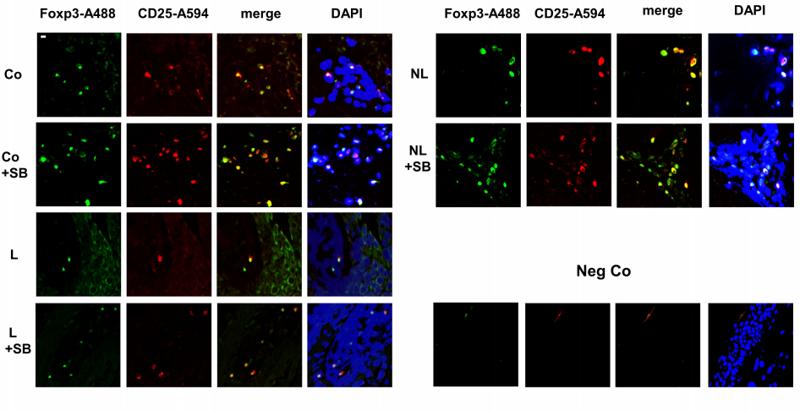产品描述
*The optimal dilutions should be determined by the end user.
*Tips:
WB: 适用于变性蛋白样本的免疫印迹检测. IHC: 适用于组织样本的石蜡(IHC-p)或冰冻(IHC-f)切片样本的免疫组化/荧光检测. IF/ICC: 适用于细胞样本的荧光检测. ELISA(peptide): 适用于抗原肽的ELISA检测.
引用格式: Affinity Biosciences Cat# AF6544, RRID:AB_2847268.
展开/折叠
AIID; DIETER; Forkhead box P3; Forkhead box protein P3; FOXP3; FOXP3_HUMAN; FOXP3delta7; Immune dysregulation polyendocrinopathy enteropathy X linked; Immunodeficiency polyendocrinopathy enteropathy X linked; IPEX; JM2; MGC141961; MGC141963; OTTHUMP00000025832; OTTHUMP00000025833; OTTHUMP00000226737; PIDX; Scurfin; XPID;
抗原和靶标
A synthesized peptide derived from human Foxp3.
- Q9BZS1 FOXP3_HUMAN:
- Protein BLAST With
- NCBI/
- ExPASy/
- Uniprot
MPNPRPGKPSAPSLALGPSPGASPSWRAAPKASDLLGARGPGGTFQGRDLRGGAHASSSSLNPMPPSQLQLPTLPLVMVAPSGARLGPLPHLQALLQDRPHFMHQLSTVDAHARTPVLQVHPLESPAMISLTPPTTATGVFSLKARPGLPPGINVASLEWVSREPALLCTFPNPSAPRKDSTLSAVPQSSYPLLANGVCKWPGCEKVFEEPEDFLKHCQADHLLDEKGRAQCLLQREMVQSLEQQLVLEKEKLSAMQAHLAGKMALTKASSVASSDKGSCCIVAAGSQGPVVPAWSGPREAPDSLFAVRRHLWGSHGNSTFPEFLHNMDYFKFHNMRPPFTYATLIRWAILEAPEKQRTLNEIYHWFTRMFAFFRNHPATWKNAIRHNLSLHKCFVRVESEKGAVWTVDELEFRKKRSQRPSRCSNPTPGP
研究背景
Transcriptional regulator which is crucial for the development and inhibitory function of regulatory T-cells (Treg). Plays an essential role in maintaining homeostasis of the immune system by allowing the acquisition of full suppressive function and stability of the Treg lineage, and by directly modulating the expansion and function of conventional T-cells. Can act either as a transcriptional repressor or a transcriptional activator depending on its interactions with other transcription factors, histone acetylases and deacetylases. The suppressive activity of Treg involves the coordinate activation of many genes, including CTLA4 and TNFRSF18 by FOXP3 along with repression of genes encoding cytokines such as interleukin-2 (IL2) and interferon-gamma (IFNG). Inhibits cytokine production and T-cell effector function by repressing the activity of two key transcription factors, RELA and NFATC2. Mediates transcriptional repression of IL2 via its association with histone acetylase KAT5 and histone deacetylase HDAC7. Can activate the expression of TNFRSF18, IL2RA and CTLA4 and repress the expression of IL2 and IFNG via its association with transcription factor RUNX1. Inhibits the differentiation of IL17 producing helper T-cells (Th17) by antagonizing RORC function, leading to down-regulation of IL17 expression, favoring Treg development. Inhibits the transcriptional activator activity of RORA. Can repress the expression of IL2 and IFNG via its association with transcription factor IKZF4 (By similarity).
Polyubiquitinated, leading to its proteasomal degradation in regulatory T-cells (Treg) which is mediated by STUB1 in a HSPA1A/B-dependent manner. Deubiquitinated by USP7 leading to increase in protein stability.
Phosphorylation at Ser-418 regulates its transcriptional repressor activity and consequently, regulatory T-cells (Treg) suppressive function. Dephosphorylated at Ser-418 by protein phosphatase 1 (PP1) in Treg cells derived from patients with rheumatoid arthritis. Phosphorylation by CDK2 negatively regulates its transcriptional activity and protein stability (By similarity).
Acetylation on lysine residues stabilizes FOXP3 and promotes differentiation of T-cells into induced regulatory T-cells (iTregs) associated with suppressive functions. Deacetylated by SIRT1.
Undergoes proteolytic cleavage in activated regulatory T-cells (Treg), and can be cleaved at either the N- or C-terminal site, or at both sites.
Nucleus. Cytoplasm.
Note: Predominantly expressed in the cytoplasm in activated conventional T-cells whereas predominantly expressed in the nucleus in regulatory T-cells (Treg). The 41 kDa form derived by proteolytic processing is found exclusively in the chromatin fraction of activated Treg cells (By similarity).
Homodimer. Dimerization is essential for its transcriptional regulator activity. Interacts with IKZF3. Isoform 1 (via LXXLL motif), but not isoform 2, interacts with isoform 4 of RORA (via AF-2 motif). Interacts with STUB1, HSPA8 and HSPA1A/B. Interacts with PPP1CA, PPP1CB and PPP1CG. Interacts with KAT5 and HDAC7. Interacts with HDAC9 in the absence of T-cell stimulation. Interacts with USP7. Interacts with isoform 2 of ZFP90 and can form a complex with TRIM28 in the presence of isoform 2 of ZFP90. Interacts with RUNX1. Interacts with RORC. Interacts with RELA and NFATC2. Interacts with RUNX2, RUNX3 and IKZF4 (By similarity).
The fork-head DNA-binding domain is essential for its dimerization and interaction with NFATC2.
研究领域
· Human Diseases > Immune diseases > Inflammatory bowel disease (IBD).
· Organismal Systems > Immune system > Th17 cell differentiation. (View pathway)
文献引用
Application: WB Species: Mouse Sample:
Application: IF/ICC Species: human Sample: PBMC
Application: IF/ICC Species: Human Sample: CRC tissues
限制条款
产品的规格、报价、验证数据请以官网为准,官网链接:www.affbiotech.com | www.affbiotech.cn(简体中文)| www.affbiotech.jp(日本語)产品的数据信息为Affinity所有,未经授权不得收集Affinity官网数据或资料用于商业用途,对抄袭产品数据的行为我们将保留诉诸法律的权利。
产品相关数据会因产品批次、产品检测情况随时调整,如您已订购该产品,请以订购时随货说明书为准,否则请以官网内容为准,官网内容有改动时恕不另行通知。
Affinity保证所销售产品均经过严格质量检测。如您购买的商品在规定时间内出现问题需要售后时,请您在Affinity官方渠道提交售后申请。产品仅供科学研究使用。不用于诊断和治疗。
产品未经授权不得转售。
Affinity Biosciences将不会对在使用我们的产品时可能发生的专利侵权或其他侵权行为负责。Affinity Biosciences, Affinity Biosciences标志和所有其他商标所有权归Affinity Biosciences LTD.






